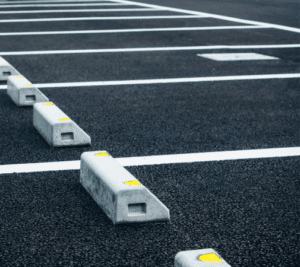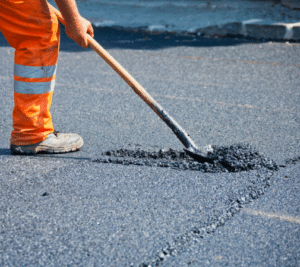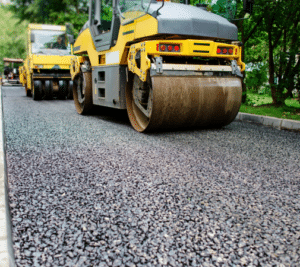You drive down a road and suddenly you notice that it looks new. The asphalt is smooth and black, without the typical cracks and potholes. But then again, you recognize some of the road as being rather familiar. Did they just resurface it or did they actually redo it? You’re not sure if that’s a good thing or a bad thing. Asphalt is porous, so water can seep into it. Old asphalt will have cracks in it and be filled with small stones, bits of grass and other debris from when it was first installed. New asphalt isn’t porous, so there’s no place for moisture to go once it rains. If you put new asphalt over old asphalt, the old asphalt will only get soggier and softer with time – which won’t be good for your car or your safety if you hit one of those potholes at high speed! If you have an existing driveway, parking lot or other paved surface that needs repairs, putting new asphalt over the old will not help matters much. The old asphalt will continue to deteriorate underneath until there’s nothing left but dirt below (and even then it might keep going). However, if the old asphalt is still in fair condition (not cracked or crumbling), then putting new gravel on top of that should extend its life substantially – perhaps even indefinitely depending on how much traffic the area gets. Read on to learn more about this process
How to Fix and Repair Paved Surfaces
If you’re looking to repair a section of asphalt, there are two options: You can tear the surface up and replace it entirely with new asphalt, or you can just fix the damaged section and leave the rest of the asphalt alone. If the asphalt is still in good condition, fixing the damaged section will be a lot easier – and cheaper! To fix the damaged surface, you’ll have to dig out the broken asphalt and the loose gravel below it, then replace that gravel with new gravel. Once the gravel has settled, you will have to lay down new asphalt on top of it. You can also use this method to repair a parking lot or driveway with a few patches here and there – which really comes in handy if you want to keep using the parking lot for the rest of the year
Why Soil Deteriorates Over Time
Before you can understand how to fix the asphalt, you have to understand why it deteriorates over time. Essentially, water gets under the asphalt and begins to erode it from the bottom up. Once the water evaporates, it leaves behind bits of minerals that were dissolved in it, which then get left behind in the asphalt as it dries out again. All of this causes the asphalt to get brittle, break up and weaken. If you drive on asphalt that’s broken up and soft, your car will likely get stuck in it.
How to Repair Paved Surground
As we mentioned above, you can replace the broken asphalt entirely with new asphalt, or you can just replace the gravel underneath it. Replacing the gravel is much easier and will cost you a lot less. However, if you do decide to replace the asphalt entirely, make sure you use a high-quality asphalt. If you use asphalt of lesser quality, it may break up again in just a few years!
Is It Okay to Put New Asphalt Over Old?
As we discussed above, you should not put new asphalt over old asphalt if the old asphalt is still in decent condition. However, it is often possible to overlay the old asphalt with new asphalt – which will effectively “replace” the old asphalt without having to tear it up and start from scratch. Let’s say your parking lot has asphalt on it that’s 30 years old, but it’s still in good condition. You can overlay the old asphalt with new asphalt. The new asphalt will be more durable and last longer than the old asphalt – so you might only have to do this once (or maybe twice).
Rebuilding a Paved Surface
The decision to replace the asphalt entirely with new asphalt is a big one. It will be a huge undertaking and will cost a lot of money. However, if the asphalt is completely shot, it may be your only option. If you do decide to go with a complete overhaul of the paved surface, make sure you put down a thick enough layer of asphalt. It’s common for people to skimpy out on the asphalt and put down too little, and then have problems with the surface cracking and breaking up.
Should You Replace the Asphalt or Just Resurface It?
If the old asphalt is in poor condition, it may be tempting to just replace it entirely with new asphalt. However, it’s often easier and cheaper to just resurface the asphalt. Resurfacing the asphalt means you will take advantage of the underlying surface and save yourself the trouble of digging it up and disposing of it. Basically, the asphalt contractor will put a new top layer on top of the old asphalt. You can choose from a variety of different materials, some of which can help to extend the life of the old asphalt (by protecting it from the sun and other elements).
Conclusion
Asphalt is a durable material that can last decades if installed properly. However, it’s a material that can also deteriorate over time and break down due to environmental factors such as sun damage and water. If you notice that your asphalt is soft, crumbling or otherwise in poor condition, there are a few ways you can fix it. Depending on the extent of the damage, you can either repair the asphalt by replacing the gravel underneath it or by putting a new top layer on top of it. Re-surfacing the asphalt can extend the life of the old asphalt and protect it from the sun and other elements that can damage it.



